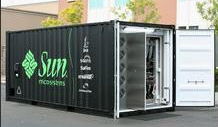Data center design 101

I don't have to design data centers, but I do have to play a knowledgeable wonk on the Web from time to time. With that in mind, I attended two data center presentations at the Gartner IT Symposium to see what I could learn.
My knowledge about the data center essentially boils down to one word: Money. Companies are building new data centers to save money on power and better utilize their computing power. Sure, cloud computing is a factor, but a small one for enterprises at this juncture. These people are building data centers in a big way. The other money point: Vendors are killing each other to be the data center king. Cisco takes on HP. IBM is in there. Oracle too (via Sun). And unfortunately for IT buyers each vendor has a different twist on data center architecture.
Simply put, I'm a data center economics major with a minor in things like raised floors, cooling systems, server racks and other items.
Here's what I learned: Companies are only building what they need. A weak economy and green IT initiatives mean that techies are increasingly going to be judged by their data center savings, says David Cappuccio, an analyst at Gartner. An efficient data center design can cut the footprint by 60 percent.
Tiers are being mixed and matched with one data center. Data centers have tiers of availability. Tier 1 is 99.6 percent uptime and Tier 4 is 99.995 percent with Tier 2 and Tier 3 in between. To build a Tier 1 10,000 square-foot facility the cost is $9.94 million. Tier 4 will run you $34.5 million, according to Gartner.
One of the more recent trends is to mix and match tiers within one facility. With this approach, you can segment applications based on the importance to the business.

Pod architecture. Cappuccio noted that previous data center design principles went like this: Build a facility for today, estimate what you'll need in 20 years, and go. Today, it's all about pods. With this approach you figure out how much space you need, say 15,000 square feet, and then build out for five to seven years. Then you add pods as you grow. Pods also allow for retrofitting so a data center complex can last 40 to 50 years.
Combine pod architectures with density zones. Cappuccio added that data centers should be designed by density zones. High-density applications (200 watts per square foot) represent 10 percent to 15 percent of a total data center usage. Medium-density apps (150 watts per square foot) account for another 20 percent. The rest is low-density (100 watts per square foot). If you mix and match densities you save money on the build-out. The density zone approach is likely to be used in the majority of new or retrofitted data centers by 2013. Double bonus if you take the pod architecture and use density zones.
The money chart:
Raised floors are passe. Anyone who has been in a traditional data center knows that raised floors, anywhere from 12 to 18 inches to 24 to 48 inches, are the norm. If you design a data center properly you can use a concrete slab for the build out. Building on a slab can be $20 per square foot cheaper than a raised floor.
And once you learn the data center principles all you have to do is evaluate all of these vendor data center visions dancing around. The field: Cisco, Oracle, HP, IBM and VMware. You can toss Dell, Microsoft, Amazon and Google into the mix too. The big takeaways from Gartner's talk on the vendor data center vision are:
- Don't get locked into anything proprietary;
- The tectonic plates between these vendors are still shifting;
- Don't let any one vendor creep to the point where it controls your budget. Data centers aren't meant to be homogeneous.
That final point is very notable. Most data center players have adjacent products and if you're not careful your entire enterprise could depend on one big name.